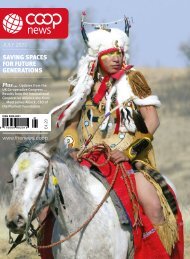Co-op News (August 2019)
What is co-operative culture - and why does it matter? This issue looks at how co-op values intersect with the values in organisations, across movements and between countries. Plus 100 years of the Channel Islands Co-operative – and how the new Coop Exchange app is tackling the capital conundrum.
What is co-operative culture - and why does it matter? This issue looks at how co-op values intersect with the values in organisations, across movements and between countries. Plus 100 years of the Channel Islands Co-operative – and how the new Coop Exchange app is tackling the capital conundrum.
You also want an ePaper? Increase the reach of your titles
YUMPU automatically turns print PDFs into web optimized ePapers that Google loves.
The paper also highlights that<br />
Desjardins has set the target of being<br />
a leader in terms of credit cards and<br />
consumer loans. This erodes the<br />
incentive to save, says the study – and it<br />
warns that Desjardins is supporting mass<br />
consumption and indebtedness.<br />
Another change ushered in by the<br />
1960s was a move away from a desire<br />
to emancipate pe<strong>op</strong>le to a desire for<br />
managerial efficiency.<br />
During this period, to free Quebec from<br />
its dependence on US capital, the leaders<br />
of the federation pr<strong>op</strong>osed the use of<br />
savings from depositors to stimulate local<br />
business devel<strong>op</strong>ment. Desjardins also<br />
started acquiring enterprises and created<br />
a number of financial subsidiaries.<br />
But while this approach offers<br />
a variety of services, the researchers<br />
say it also affects the co-<strong>op</strong>erative's<br />
mission. Because they provide complex<br />
financial services, these subsidiaries<br />
are run by professionals who are not<br />
familiar with the co-<strong>op</strong>erative movement<br />
– which means they might have<br />
problems integrating.<br />
To address this, the confederation<br />
has decision-making power for the<br />
whole movement of caisses, controlling<br />
the subsidiaries and centralising the<br />
resources of the individual caisses.<br />
The report claims the federation no<br />
longer aims to put in place measures that<br />
contribute to the economic emancipation<br />
of its members, but rather to maximise<br />
returns and surpluses. And those who<br />
run the federation now come from<br />
management schools or the banking<br />
community, it adds: and because its<br />
management is no longer politically<br />
active but paid professionals, Desjardins<br />
has lost its mission.<br />
The report says another big<br />
transformation took place during<br />
the 1990s due to legislative changes.<br />
Traditionally banks had been forbidden<br />
from combining traditional banking<br />
and market activities, such as securities<br />
issues, insurance, brokerage and fiduciary<br />
management. But in 1991, changes to the<br />
law enabled them to form large financial<br />
conglomerates, regrouping several or all<br />
fields of financial activity.<br />
Because Desjardins was classed as a<br />
local bank it never had to comply with<br />
the law. From the 1990s, the situation<br />
changed and it started facing competition<br />
from other banks; the movement had to<br />
enter new markets.<br />
Since it cannot acquire capital by<br />
issuing shares, Desjardins could not raise<br />
capital when it wanted, as other banks<br />
could. After lobbying the government to<br />
enable it to have access to funds, a change<br />
in legislation enabled it to issue securities<br />
to raise funds from investors. This also<br />
means that the yield (interest) offered to<br />
investors must be high enough for them to<br />
want to invest in the first place.<br />
To attract investment, the report says,<br />
Desjardins started ad<strong>op</strong>ting similar<br />
criteria to other banks. Remuneration<br />
also resembles that of traditional banks,<br />
focused on bonuses dependant on how<br />
the bank is performing.<br />
In its 2000 annual report Desjardins<br />
said that it chose to comply with capital<br />
requirements imposed by international<br />
regulators. The federation began to<br />
increasingly define itself by the credit<br />
ratings granted to it by the major rating<br />
agencies. And since 2013, Desjardins has<br />
been considered one of the banks that are<br />
“too big to fail” and has to comply with<br />
Basel III regulations.<br />
To improve performance, the federation<br />
started devel<strong>op</strong>ing a culture similar to<br />
that of traditional banks. The report says<br />
this is noticeable across three different<br />
areas: the organisation of work inside<br />
the caisses; <strong>op</strong>erating costs; and the<br />
organisational structure.<br />
In terms of changes within the<br />
branches, many services were automated<br />
while service became more personalised,<br />
with cashiers being replaced by advisers.<br />
Advisers also get financial incentives<br />
for selling the most beneficial financial<br />
products for Desjardins.<br />
The reducing of <strong>op</strong>erating costs is<br />
visible in two ways. The first is the<br />
merger or closure of the caisses that have<br />
low growth potential. The movement<br />
went from 1,350 caisses in Quebec in<br />
1990 to 671 in 2002. It now has just<br />
238 caisses.<br />
“CONTRARY TO WHAT ALPHONSE<br />
DESJARDINS WANTED, CAPITAL IS<br />
NO LONGER A MEANS, IT HAS BECOME<br />
THE MAIN OBJECTIVE,”<br />
The second cut in costs came in the<br />
amount paid to members via rebates –<br />
which depends on how much members<br />
spend with the co-<strong>op</strong>.<br />
The amount spent on rebates in 2016<br />
decreased by more than two-thirds since<br />
2002: from CA $490m to $144m – or 58%<br />
of the surplus amount in 2002, falling to<br />
8% in 2016.<br />
The total amount returned to members<br />
in 2017 was $202m while in 2018 this<br />
amounted to $253m. While there has<br />
been an increase, these figures represent<br />
only 9.4% and 10.9% of the annual<br />
surplus, says the report. Members who<br />
have more financial products with the<br />
co-<strong>op</strong> are rewarded more than those who<br />
do not use all of its services.<br />
The research argues that the closure<br />
of branches and the lowering of rebates<br />
paid to members impacted the mission of<br />
the co-<strong>op</strong>, which was set up by Alphonse<br />
Desjardins to provide financial services<br />
to those who could not afford them.<br />
After outside investors were attracted<br />
in the 1990s, Desjardins’ structure<br />
with local branches, regional caisses<br />
and the national federation also<br />
changed. The regional caisses were<br />
abolished and the leading organisation<br />
is now the central federation of caisses<br />
of Quebec.<br />
AUGUST <strong>2019</strong> | 39


















